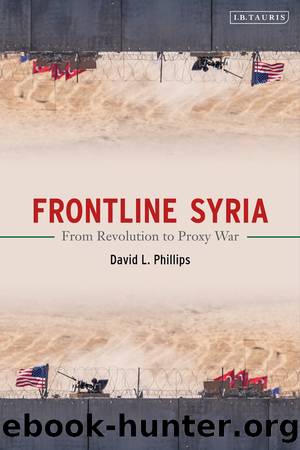Frontline Syria by David L. Phillips

Author:David L. Phillips
Language: eng
Format: epub
Publisher: Bloomsbury Publishing Plc
12
Armenians and Christians
Our weapon is the prayer, the spreading of spirit of love, brotherhood and tolerance.1
âOmar, Administrator of the Protestant Church in Kobani
*****
The historic homeland of Armenians encompasses territory in what is today the Republic of Armenia, as well as lands incorporated into the Republic of Turkey that Armenian nationalists refer to as Western Armenia. Beginning in 1915, the Ottoman Empire deported ethnic Armenians from Anatolia. As many as 1.5 million Armenians died between 1915 and 1923 in what is known as the Armenian Genocide. A mass grave of Armenian victims is located outside of Deir ez-Zor in eastern Syria. Human bones protrude from the ground with remains scattered across a barren desert.2 Up to 100,000 survivors of the Armenian Genocide resettled in Syria, seeking sanctuary for their Church and civilization.
Faith is fundamental to Armenians, with victimization at the core of their collective identity. The principles of self-sacrifice and martyrdom are foundational not only to Armenians but also to all Christians. Christianity teaches that those who are willing to suffer and die for their faith are saved through their devotion to Jesus Christ. It is written in Galatians, âJesus gave his life for our sins, just as God our Father planned, in order to rescue us from this evil world in which we live.â3 Devotees believe in the power of prayer and bestowing loving kindness even toward an aggressor.
Jesus spent some of His ministry in Syria and made Peter the first Pope while in Syria.4 When the Islamic State in Iraq and Syria (ISIS) stormed across the Iraqi border in June 2014, it targeted apostatesâShiites, Kurds, Yezidis, and Christians. Mosul, Iraqâs second-largest city, was overrun by ISIS. Its sixty thousand Christians were executed, displaced, or trafficked as sex slaves. The same fate befell Christians in the Nineveh Plains and North and East Syria (NES). ISIS seized ancient churches, some nearly 2,000 years old, and converted them into mosques, madrassas, and prisons. They tore down crosses from the churches and used chisels to deface tombstones in church graveyards. Syriaâs Christian population was 250,000 in 2011. Only thirty thousand remained in Syria by the end of 2016.5
ISIS envisioned a worldwide jihad against Christians. The ISIS magazine, Dabiq, displayed images of crucified Christians as âa message in blood written to the Nation of the Cross.â6 Dabiq featured a picture of St. Peterâs Square with an ISIS flag superimposed atop its holy obelisk. Abu Bakr al-Baghdadi, the ISIS founder and self-declared caliph, said his fighters would march âall the way to Rome,â and along the way, âbreak the crosses [and] trade and sell their women.â7 When ISIS occupied a Christian community, it offered residents a stark choice: forced conversion, slavery, extortion, or execution.
Some Muslims opposed Baghdadiâs harsh terror tactics and deemed these tactics as un-Islamic. They pointed out that the Prophet Muhammad taught mercy and humanitarian action. The term âJihadâ was not meant to legitimize the carnage of nonbelievers. Rather, it described an act of self-improvement for devotees on a spiritual path. King Abdullah
Download
This site does not store any files on its server. We only index and link to content provided by other sites. Please contact the content providers to delete copyright contents if any and email us, we'll remove relevant links or contents immediately.
| Africa | Americas |
| Arctic & Antarctica | Asia |
| Australia & Oceania | Europe |
| Middle East | Russia |
| United States | World |
| Ancient Civilizations | Military |
| Historical Study & Educational Resources |
The Battle of Mogadishu by Matt Eversmann & Dan Schilling(723)
The Confidence Men by Margalit Fox(671)
A History of the Muslim World since 1260: The Making of a Global Community by Vernon O. Egger(641)
The Spymaster of Baghdad by Margaret Coker(641)
Jack the Ripper and the East End by Peter Ackroyd(609)
Empire of Fear: Inside the Islamic State by Andrew Hosken(586)
The Afghanistan File by Prince Turki AlFaisal Al Saud(586)
The Crimean War by Winfried Baumgart(578)
Islam At The Gates: How Christendom Defeated the Ottoman Turks by Diane Moczar(571)
The Jerusalem Diamond by Noah Gordon(567)
Akhenaten by Dominic Montserrat(565)
A Concise History of Greece (Cambridge Concise Histories) by Richard Clogg(554)
Beirut 2020 by Charif Majdalani(554)
The History of Jihad by Robert Spencer(547)
Israel: Ancient Kingdom or Late Invention? by Daniel I. Block(532)
Enemy in the East by Rolf-Dieter Müller(532)
The Privatization of Israeli Security by Shir Hever(524)
The Nine Lives of Pakistan by Declan WALSH(521)
Destroying a Nation: The Civil War in Syria by Nikolaos van Dam(515)
